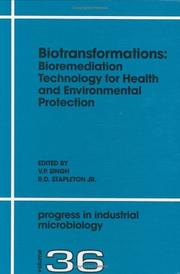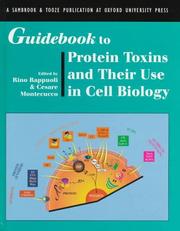| Listing 1 - 10 of 65 | << page >> |
Sort by
|

ISBN: 9780444509970 0444509976 9780080528205 0080528201 1281186767 9781281186768 9786611186760 661118676X Year: 2002 Publisher: New York Elsevier Science Ltd
Abstract | Keywords | Export | Availability | Bookmark
 Loading...
Loading...Choose an application
- Reference Manager
- EndNote
- RefWorks (Direct export to RefWorks)
This volume provides a clear understanding of how microbes, following their degradative processes, contribute maximally to the benefit of mankind through biotransformations of waste materials as well as a wide variety of health-risk compounds. The book contains twenty four chapters contributed by leading scientists from different parts of the world, covering various aspects of bioremediation of xenobiotics such as toxic, carcinogenic, teratogenic, and mutagenic compounds, which include halogenated aromatics, derivatives of heavy metals, microbial toxins, tannins, dyes, sulfur compounds o
Biodegradation. --- Biotransformation (Metabolism) --- Metabolic detoxification. --- Bioremediation.
Book
Abstract | Keywords | Export | Availability | Bookmark
 Loading...
Loading...Choose an application
- Reference Manager
- EndNote
- RefWorks (Direct export to RefWorks)
Metals such as copper, iron, manganese, and zinc are clearly required for proper metabolism and development, while imbalances can lead to systemic dysfunction and disease. As a result, organisms have evolved complex genetic systems for the regulation of metal levels, including import, export, and sequestration of metals within cells and sub-cellular compartments.
The study of metal biology in insects has the potential to greatly expand our understanding of metal biology. The results of such studies might point to new possible therapeutic interventions for neurological and other human diseases, as well as new strategies for insect disease vector control.
The articles collected in this Research Topic comprise review and original research on metal biology in insects.
metal biology --- metal homeostasis --- detoxification --- insects
Book
ISBN: 1316496821 1316497488 1316497151 1316498808 1316411419 1107126975 1107565731 1316494519 9781316411414 9781316498804 9781316497487 9781107126978 9781107565739 9781316496824 9781316497159 9781107126978 9781107565739 Year: 2016 Publisher: Cambridge, United Kingdom
Abstract | Keywords | Export | Availability | Bookmark
 Loading...
Loading...Choose an application
- Reference Manager
- EndNote
- RefWorks (Direct export to RefWorks)
Toxic Histories combines social, scientific, medical and environmental history to demonstrate the critical importance of poison and pollution to colonial governance, scientific authority and public anxiety in India between the 1830s and 1950s. Against the background of India's 'poison culture' and periodic 'poison panics', David Arnold considers why many familiar substances came to be regarded under colonialism as dangerous poisons. As well as the criminal uses of poison, Toxic Histories shows how European and Indian scientists were instrumental in creating a distinctive system of forensic toxicology and medical jurisprudence designed for Indian needs and conditions, and how local, as well as universal, poison knowledge could serve constructive scientific and medical purposes. Arnold reflects on how the 'fear of a poisoned world' spilt over into concerns about contamination and pollution, giving ideas of toxicity a wider social and political significance that has continued into India's postcolonial era.
Toxins --- Natural toxicants --- Toxicants, Natural --- Toxins and antitoxins --- Antigens --- Metabolites --- Poisons --- Antitoxins --- Detoxification (Health) --- History.
Book
ISBN: 3038428620 Year: 2018 Publisher: Basel, Switzerland : MDPI,
Abstract | Keywords | Export | Availability | Bookmark
 Loading...
Loading...Choose an application
- Reference Manager
- EndNote
- RefWorks (Direct export to RefWorks)
Venoms from marine and terrestrial animals (cone snails, scorpions, spiders, snakes, centipedes, cnidarian, etc.) can be seen as untapped cocktails of biologically active compounds that are being increasingly recognized as a new emerging source of peptide-based therapeutics. Venomous animals are considered to be specialized predators that have evolved the most sophisticated peptide chemistry and neuropharmacology for their own biological purposes by producing venoms that contain a structural and functional diversity of neurotoxins. These neurotoxins appear to be highly selective ligands for a wide range of ion channels and receptors. Therefore, they represent interesting lead compounds for the development of analgesics, anti-cancer drugs, drugs for neurological disorders such as multiple sclerosis, Parkinson' s disease, Alzheimer' s disease, and other therapeutics. This Special Issue of Toxins aims to provide a comprehensive look at toxins and toxin-inspired leads and will focus on the mechanisms of action, structure-function relationships, and evolution of pharmacologically interesting venom components, including the most recent developments related to the emergence of venoms as an underutilized source of highly evolved bioactive peptides with clinical potential.
Toxins. --- Natural toxicants --- Toxicants, Natural --- Toxins and antitoxins --- Antigens --- Metabolites --- Poisons --- Antitoxins --- Detoxification (Health)
Book
ISBN: 3036570918 303657090X Year: 2023 Publisher: Basel, Switzerland : MDPI - Multidisciplinary Digital Publishing Institute,
Abstract | Keywords | Export | Availability | Bookmark
 Loading...
Loading...Choose an application
- Reference Manager
- EndNote
- RefWorks (Direct export to RefWorks)
The lifestyle associated with good quality of food is well known for its widely recognized health benefits, especially when rich in bioactive compounds. Reduced risks of some types of cancer and other diseases have been associated with the adoption of such a diet, as have increased antioxidants, inhibitors of lipid peroxidation, decrease of pro-inflammatory cytokine production, etc. The focus of this Special Issue of Toxins was to gather advances related to the cytotoxicity of natural toxins and the potential for the cytoprotection of natural compounds present in food or plants. In this context, this Special Issue of Toxins comprises eight original contributions. Special attention is given to Fridericia chica (Bignoniaceae) leaves grown in Colombia, extract from Polygonum cuspidatum, Artemisia annua and coffee extracts against mycotoxins ́ effects. Studies of mycotoxins in different animal and human cell lines are also presented for zearalenone, beauvericin, α-zearalenol and β-zearalenol, among others.
Toxins. --- Natural toxicants --- Toxicants, Natural --- Toxins and antitoxins --- Antigens --- Metabolites --- Poisons --- Antitoxins --- Detoxification (Health)
Book
ISBN: 3036569057 3036569049 Year: 2023 Publisher: Basel, Switzerland : MDPI - Multidisciplinary Digital Publishing Institute,
Abstract | Keywords | Export | Availability | Bookmark
 Loading...
Loading...Choose an application
- Reference Manager
- EndNote
- RefWorks (Direct export to RefWorks)
Toxins are biologically active substances produced by most kinds of living organisms, bacteria, fungi, plants, and animals. They present a vast diversity of molecular structures and target a wide variety of receptors involved in a range of physiological processes. As toxins are selected during evolution to acquire/improve their disabling/lethal effects, they display finely tuned functional properties often associated with high affinities and selectivity. Moreover, toxins are valuable tools to unravel cellular processes due to their extreme specificity for cell surface and/or intracellular targets. Therefore, toxins are very attractive compounds because of their Janus-like character; while they mostly act as deadly poisons like monstrous Mr. Hyde, they can also be tamed into good remedies like admirable Dr. Jekyll. As such, they have been primarily investigated not only for the light they can throw on fundamental physiological processes but also for their potential therapeutic applications. This book, emerging from the 27th Annual Meeting of the French Society of Toxinology (SFET, http:sfet.asso.fr/international), will be of great interest for those in the scientific community who want to know more about the fascinating world of toxins.
Toxins. --- Natural toxicants --- Toxicants, Natural --- Toxins and antitoxins --- Antigens --- Metabolites --- Poisons --- Antitoxins --- Detoxification (Health)
Book
Year: 2019 Publisher: Frontiers Media SA
Abstract | Keywords | Export | Availability | Bookmark
 Loading...
Loading...Choose an application
- Reference Manager
- EndNote
- RefWorks (Direct export to RefWorks)
This eBook is a collection of articles from a Frontiers Research Topic. Frontiers Research Topics are very popular trademarks of the Frontiers Journals Series: they are collections of at least ten articles, all centered on a particular subject. With their unique mix of varied contributions from Original Research to Review Articles, Frontiers Research Topics unify the most influential researchers, the latest key findings and historical advances in a hot research area! Find out more on how to host your own Frontiers Research Topic or contribute to one as an author by contacting the Frontiers Editorial Office: frontiersin.org/about/contact
glutathione transferases --- catalysis --- detoxification --- glutathionylation --- ligand binding --- redox state --- gene regulation --- secondary metabolism

ISBN: 1280375302 9786610375301 0585484228 9780585484228 9781280375309 0198599552 9780198599555 0198599544 9780198599548 Year: 1997 Publisher: Oxford New York Oxford University Press
Abstract | Keywords | Export | Availability | Bookmark
 Loading...
Loading...Choose an application
- Reference Manager
- EndNote
- RefWorks (Direct export to RefWorks)
Many bacteria, animals, and plants produce toxins that can prove lethal to other organisms. Toxins are a form of "biological warfare" that helps their producer to survive and so confer an evolutionary advantage. They display an extraordinary range of complexity, from the formic acid provided by ants to bacterial proteins composed of thousands of amino acids. This Guidebook considers the more complex protein and peptide toxins and groups them according to their mode of action.; Topics covered include: membrane-permeabilizing toxins; toxins affecting signal transduction and protein synthesis; cytoskeleton-affecting toxins; toxins affecting the immune and inflammatory response. This class of biomolecules will be of interest to a wide range of researchers in cell biology,; neuroscience, and toxicology.
Toxins. --- Natural toxicants --- Toxicants, Natural --- Toxins and antitoxins --- Antigens --- Metabolites --- Poisons --- Antitoxins --- Detoxification (Health) --- Toxins - Handbooks, manuals, etc.
Book
ISBN: 0309572827 9780309572828 Year: 1994 Publisher: Washington, DC National Academy Press
Abstract | Keywords | Export | Availability | Bookmark
 Loading...
Loading...Choose an application
- Reference Manager
- EndNote
- RefWorks (Direct export to RefWorks)
Toxicology --- Toxins --- Natural toxicants --- Toxicants, Natural --- Toxins and antitoxins --- Antigens --- Metabolites --- Poisons --- Antitoxins --- Detoxification (Health) --- Chemicals --- Medicine --- Pharmacology --- Poisoning --- Research
Book
ISBN: 0124165990 0124165958 1322053758 9780124165991 9780124165953 Year: 2015 Publisher: London, England : Elsevier : AP,
Abstract | Keywords | Export | Availability | Bookmark
 Loading...
Loading...Choose an application
- Reference Manager
- EndNote
- RefWorks (Direct export to RefWorks)
The Heart and Toxins brings together global experts to provide the latest information and clinical trials that make the connection between genetic susceptibility, gene expression, and environmental factors in cardiovascular diseases. This unique reference, edited by renowned cardiologist Meenakshi Sundaram Ramachandran, solves the problem of managing multiple clinical cases of cardiovascular toxicity. It allows connections to be made between research, diagnosis, and treatment to avoid higher morbidity and mortality rates as a result of cardiovascular toxicity.Structured to bring together explo
Heart --- Toxins. --- Heart. --- Diseases. --- Cardiopulmonary system --- Cardiovascular system --- Chest --- Natural toxicants --- Toxicants, Natural --- Toxins and antitoxins --- Antigens --- Metabolites --- Poisons --- Antitoxins --- Detoxification (Health) --- Cardiac diseases --- Heart diseases --- Cardiology
| Listing 1 - 10 of 65 | << page >> |
Sort by
|

 Search
Search Feedback
Feedback About UniCat
About UniCat  Help
Help News
News